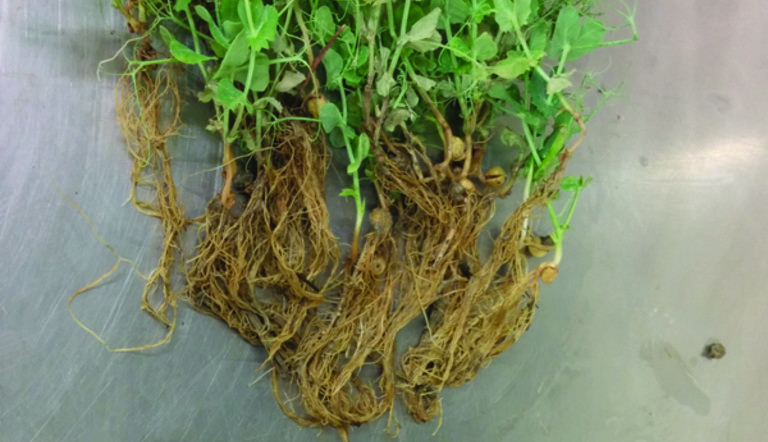
Pest Profile: Aphanomyces Root Rot
A severe infection or one that lasts throughout the growing season can devastate a field, while a late-season or mild infection may just lead to lodging at harvest. Symptoms can appear anytime from June to pre-harvest, and the more advanced the disease gets, the harder it is to pinpoint, so if you suspect aphanomyces, it’s best to send samples to a diagnostic lab to be sure.

IDENTIFICATION
Primary symptoms of Aphanomyces root-rot occur on roots and subterranean stem tissues. Initial symptoms are gray, water-soaked root tissue, which may later become soft and honey-brown or blackish-brown. Roots may reduce in volume and have decreased nodulation. As the fungus spreads to the stem of the plant, chlorosis, necrosis and wilting of foliage may occur.
Aphanomyces prefers waterlogged conditions, like those found in low areas of the field, side-hill seep sand clay soils with water-holding capacity. If these conditions are present in your field, keep an eye out for poor emergence, stunting and yellowing of leaf tissue, nodules that are under-developed or pale looking and a reduced root system.
CONTROL TIPS
- Plant peas, lentils and other susceptible crops in fields with sandier soils and good drainage.
- Plant good quality seed to avoid inoculum build-up in the soil.
- Thoroughly clean boots and equipment if working in a field with a known infection.
- Slow inoculum build-up by using a six-year crop rotation, if possible.
NOTE ABOUT CHEMICAL CONTROL
There is one Group 22 (ethaboxam) seed treatment registered for the suppression of seed rot caused by aphanomyces. However, there is currently no product registered for its control, as there are no registered fungicides with the systemic activity needed to control aphanomyces at the root level.
Fortunately, 2017 saw a sharp decrease in Canadian fields affected by Aphanomyces, and disease pressure has continued to decline in 2018 due to drier summer weather.
REFERENCES AND ADDITIONAL READING
“Aphanomyces Root Rot (Common Root Rot) of Legumes).” The American Phytopathological Society. Online. https://bit.ly/2MusPBi
Fleury, Donna. “Aphanomyces root rot expanding across Western Canada.” Top Crop Manager. 7 Apr 2017. Online. http://bit.ly/2qXZjsp
“Root Rot in Pea and Lentil in Western Canada.” Alberta Pulse Growers. Online. http://bit.ly/2qYkt9M
“The re-emergence of aphanomyces root rot in Saskatchewan.” Pulse Advisor Radio Program Online with Sherrilyn Phelps. 15 Jun 2016. http://bit.ly/2rDrwqH